#jagiellonian
Explore tagged Tumblr posts
Text


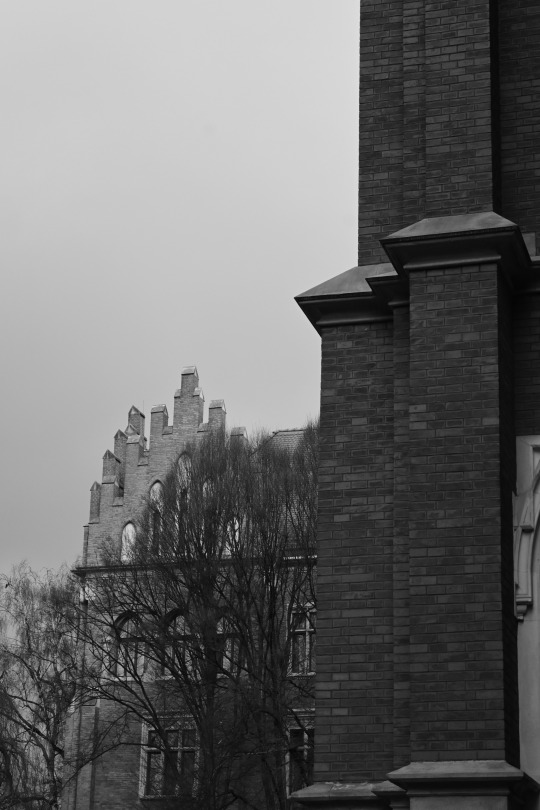
bricked walls
#krakow#poland#jagiellonian#b&w#b&w photography#nikon#nikon z30#street photography#street pics#winter#photography
9 notes
·
View notes
Text

Elizabeth of Austria (1436-1505) Queen of Poland and Grand Duchess of Lithuania as the wife of King Casimir IV of Poland.
#haus habsburg#erzherzogin#archduchess#österreich#erzherzogtum österreich#house of habsburg#queen consort#queen consort of poland#Elżbieta Rakuszanka#elizabeth of austria#Elžbieta Habsburgaitė#elisabeth von habsburg#królestwo polskie#Jagiellonian dynasty#Jagiellonian#House of Jagiellon#dynastia jagiellońska#dynastia Jagiellonów
3 notes
·
View notes
Text

Polish actor Krzysztof Świłpa as Władysław III of Poland (31 October 1424 – 10 November 1444), also known as Władysław (Ladislaus) III Jagiellon/Władysław of Varna – King of Poland, Hungary and Croatia as well as Supreme Duke of the Grand Duchy of Lithuania
"[...] it was from his reign that the thinking of Poland as the “bulwark of Christianity” started to develop, so popular later in the 16th and 17th century. In the 15th century, during the reign of Władysław III, the term “bulwark” referred rather to Hungary, threatened by the progressing Turkish expansion, but it was precisely for this purpose that the young king of Poland accepted the Hungarian crown – in order to fight for defending the Kingdom of Hungary. Military successes during the so-called “long campaign” (1443/1444) resulted in the fact that he individually became to be referred to as a “bulwark of the entire Christian Commonwealth” – and not by somebody else but by Francesco Filelfo, one of the greatest snobs, but also the most outstanding erudite humanist of the Italian Renaissance, who was sought after by the most outstanding people of the time, including monarchs and even the pope. Prof. Janusz Tazbir correctly notices that it was at that time that the term antemurale Christianitatis – already widespread in Europe – was for the first time used towards the Polish ruler (!) and not the Kingdom of Poland. For the achieved victories, Władysław III as the first Polish ruler received from the Pope a blessed sword – a special distinction for rulers who distinguished themselves in fighting for the defence of Christian faith". (© Ewa Srebro, Maria Curie Skłodowska University in Lublin)
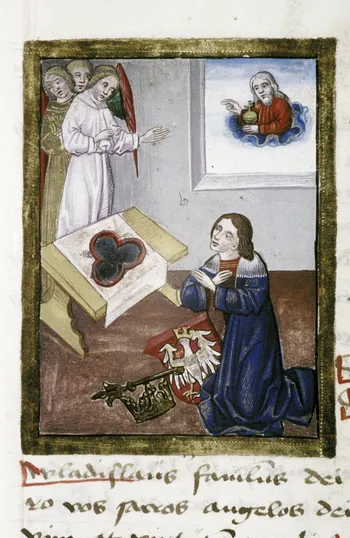
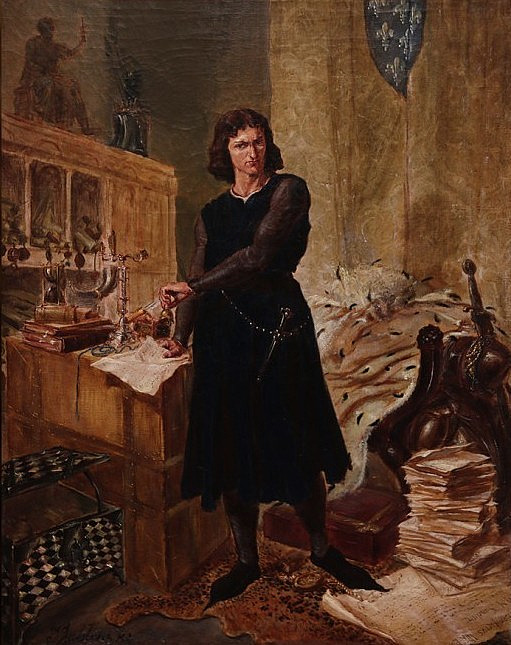
1) Władysław III depicted in a 15th-century prayerbook, 2) Władysław III by Izydor Jabłoński
#władysław warneńczyk#monarchy#ladislaus of varna#krzysztof świłpa#wladyslaw of varna#władysław of varna#poland#hungary#polish history#jagiellonian dynasty#royalty#catholic#catholicism#roman catholic#roman catholicism#15th century#christianity#christian#kingdom of poland#władysław jagiellończyk#historyblr
15 notes
·
View notes
Text

Saint Casimir (1458-1484), prince and patron saint of Poland. Attributed to Agostino Masucci.
He was the third child and the second son of the King of Poland and Grand Duke of Lithuania Casimir IV and Queen Elisabeth Habsburg of Austria.
#agostino masucci#saint casimir#saints#catholic church#patron saint#kingdom of poland#Korona Królestwa Polskiego#Królestwo Polskie#Jagiellonian dynasty#Jagiellonowie
10 notes
·
View notes
Text
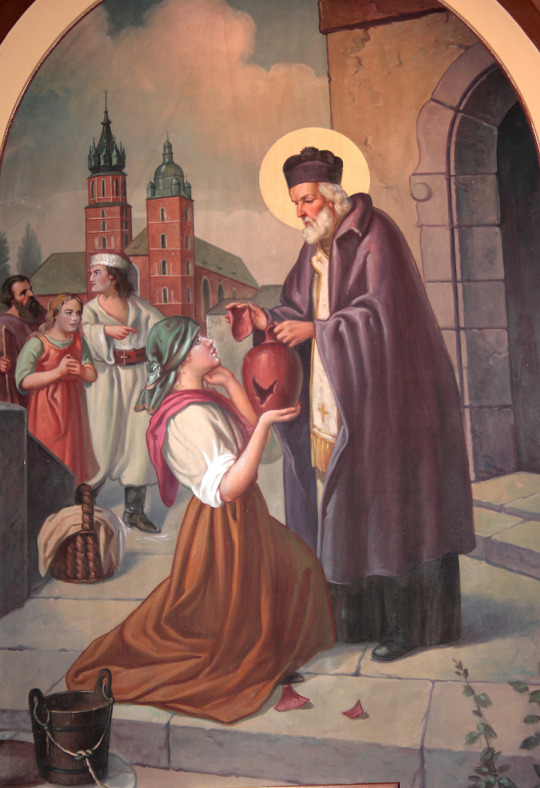
THE DESCRIPTION OF SAINT JOHN CANTIUS The Patron of Poland, Lithuania and Jagiellonian University Feast Day: December 23
The great scholar of Poland, John Cantius or John of Kanty, was born on June 23, 1390, in Kęty, Oświęcim, Crown of the Kingdom of Poland (now known as Kraków), to Anna and Stanisław Kanty.
After his ordination, he taught for many years at the University of Kraków (now Jagiellonian University) at which he attained bachelor, and licentiate, endeavoring to train his students not only in science, but also in spirituality. He distinguished himself as an orthodox teacher of the faith. He was never weary of telling his students to fight false opinions, but he added: 'Let your weapons be patience, sweetness and love. Roughness is bad for your own soul and spoils the best cause.'
John was known to lead a strict life, sleeping on the bare floor and never eating meat. When he was warned to look after his health, he replied: 'The fathers of the desert were notably long-lived despite their fasting and penance.'
One day as he was dining, a beggar passed by the door of his residence. At once, he carried out all his food to the poor man. When he returned to his seat, he found his plate again full of food. This was long commemorated in the university by setting aside a special meal for a poor person every day. For a time, he was assigned at Olkusz (situated in the Lesser Poland Voivodeship), proving himself a zealous and beloved parish priest.
There is a story of a time when he encountered a crying servant girl who had dropped and broken a jug, and who was in dread of being punished. John prayed for her as he helped her pick up the pieces of the jug. His prayers made the broken jug whole again, and the water with which it had been filled had turned into sweet, rich milk.
On December 24, 1473, John died while living in retirement at his alma mater at the age of 83. Pope Clement XIII said of him: 'He deserves a place among the great scholars who practice what they preach.'
His feast day was first inserted into the General Roman Calendar in 1770, it was initially assigned to October 20th, but in the calendar reform of 1969 it was moved to December 23rd, the day before the anniversary of his death. Beatified by Pope Clement X in 1676, named as the patron of Poland and Lithuania by Pope Clement XII in 1737, and canonized as a saint by Pope Clement XIII in 1767. The Roman Breviary distinguishes him with three hymns; he is the only confessor not a bishop who has been given this honor in the Catholic liturgy.
His major shrine can be found at the Church of St. Anne in Kraków, Poland.
#random stuff#catholic#catholic saints#john kanty#john cantius#juan cancio#poland#lithuania#jagiellonian university
4 notes
·
View notes
Text
You have to understand that the Opera Clock from Jagiellonian university is my favourite object in the wrold.
6 notes
·
View notes
Text
Three Days in Kraków
#amber#Auschwitz#Boleslawiec potttery#Cloth Hall#Dietla#Dragon#English Football Club#Jagiellonian University#Karol Wojtyla#Kazimierz#Kogel Mogul#Kosciusko#krakow#Nolio&039;s#Poland#Polish History#PolishOrigins#Pope John Paul II#Queen Boutique Hotel#Rynek#Rynek Glowny#Schindler#Shindler&039;s List#Sigismund Bell#Smok Waweleski#St. Mary&039;s Basilica#Wawel#Wawel Castle
0 notes
Text
St Jadwiga of Anjou, the King of Poland – A guest post by Katarzyna Ogrodnik-Fujcik
Jadwiga as depicted by Jan Matejko. Imaginary portrait based on a series of drawings the artist made upon examining her resting place in 1187. The Freelance History Writer is pleased to welcome back Katarzyna Ogrodnik-Fujcik with an exclusive article on an exceptional woman from Polish medieval history. In January 1887, a group of scholars and artists explored the grave of Jadwiga [Hedwig] of…
#Elizabeth of Bosnia#Hedwig#House of Anjou#Jadwiga#Jan Matjko#King Casimir the Great#King Louis the Great#King of Poland#Ladislaus Jagiellonian#Medieval History#Piast dynasty#Polish history
1 note
·
View note
Text
Not Quite The Trip We Had Planned, Part 2: Kraków, Poland

View On WordPress
#Jagiellonian University#Main Square#Old Town#Warsaw Uprising Museum#Wawel Royal Castle#Wonder Woman
0 notes
Text
🇵🇸🇵🇸 LISTY OTWARTE DO REKTORÓW UJ, UWR ORAZ UW // OPEN LETTERS TO THE RECTORS OF UJ, UWR AND UW 🇵🇸🇵🇸
POLISH:
Jeśli szukasz sposobu na wsparcie trwającej walki o wolną Palestynę:
Obecnie toczą się trzy listy otwarte skierowane do rektorów Uniwersytetu Jagiellońskiego, Uniwersytetu Warszawskiego i Uniwersytetu Wrocławskiego, wzywające do m.in. natychmiastowego zaprzestania współpracy z izraelskimi instytucjami akademickimi.
Może je podpisać każdy, pod warunkiem, że jest w jakimś stopniu związanym z edukacją wyższą. Może to być jako student, członek kadry, itp. LICZĄ SIĘ TEŻ INSTYTUCJE MIĘDZYNARODOWE!!
Mamy jeszcze kilka dni na zebranie jak największej liczby podpisów! Byłabym bardzo wdzięczna, jeśli możesz poświęcić kilka minut na podpisanie listów i udostępnienie ich każdemu, kto mógłby być zainteresowany
(pełne listy w języku polskim i angielskim dostępne są w linkach poniżej)
_ _ _ _ _ _ _ _ _ _ _ _ _ _ _ _ _ _ _ _ _ _ _ _ _ _ _ _ _ _ _ _ _ _ _ _ _
ENGLISH:
if you're looking for a way to support the ongoing fight for a free Palestine
there's currently three open letters directed at the rectors of the Jagiellonian University, University of Warsaw and the University of Wrocław demanding among others an immediate cease of cooperation with Israeli academic institutions.
They can be signed by anyone as long as you're involved with higher education in some regard. It can be as a student, faculty member or other. INTERNATIONAL INSTITUTIONS ALSO COUNT!!
We still have a few days to get as many signatures as possible! it would mean the world if you could take a few minutes to sign the letters if you can and share with anyone who could be interested
(the full letters in both polish and english are available in the links below)
(if have any other questions, i'll try answering them to the best of my ability)
#free palestine#palestine#free gaza#current events#palestine will be free#polska#poland#warszawa#wrocław#warsaw#kraków#save rafah#save gaza#gaza#all eyes on rafah#pro palestine
710 notes
·
View notes
Text
Polish police are investigating antisemitic signs that were spotted among banners that pro-Palestinian, anti-Israel students hung outside a Krakow university building that they have occupied for over six months, local media reported Thursday.
The Gazeta Wyborcza newspaper said the signs, including one reading “Jews to the gas,” were spotted Monday morning on a wall outside the Collegium Broscianum, which houses the sociology and philosophy departments of the Jagiellonian University, Poland’s oldest university, which has a long history of antisemitism.
99 notes
·
View notes
Text
Researchers from Durham University, Jagiellonian University (Poland) and the John Innes Center have achieved a breakthrough in understanding DNA gyrase, a vital bacterial enzyme and key antibiotic target. This enzyme, present in bacteria but absent in humans, plays a crucial role in supercoiling DNA, a necessary process for bacterial survival. Using high-resolution cryo-electron microscopy, the researchers reveal unprecedented detail of gyrase's action on DNA, potentially opening doors for new antibiotic therapies against resistant bacteria. The research is published in Proceedings of the National Academy of Sciences.
Continue Reading.
60 notes
·
View notes
Text

Left to Right: Rudolf I. von Habsburg, Isabella the Catholic, Ferdinand the Catholic, Sigismund I of Poland, Mathias Corvinus, Carl V. (Charles V), Maximilian I., from the Illustrierte Weltgeschichte für das Volk: Geschichte des Mittelalters (1883)
#royalty#haus habsburg#house of habsburg#erzherzogtum österreich#heiliges römisches reich#königreich ungarn#magyar királyság#monarquía española#reino de españa#casa de trastámara#królestwo polskie#Jagiellonian dynasty#hunyadi#Familia Corvineștilor
7 notes
·
View notes
Text

• Stanisław Sosabowski
Stanisław Franciszek Sosabowski was a Polish general in World War II. He fought in the Polish Campaign of 1939 and at the Battle of Arnhem (Netherlands), as a part of Operation Market Garden, in 1944 as commander of the Polish 1st Independent Parachute Brigade.
Stanisław Sosabowski was born on May 8th, 1892 in Stanislau, in what was then Austria-Hungary and is now Ivano-Frankivsk in western Ukraine. His father was a railway worker. Sosabowski graduated from a local gymnasium and in 1910 he was accepted as a student of the faculty of economy of the Jagiellonian University in Kraków. However, the death of his father and the poor financial situation of his family forced him to abandon his studies and return to Stanislau. There he became a member of Drużyny Strzeleckie, a semi-clandestine Polish national paramilitary organisation. He was soon promoted to the head of all Polish Scouting groups in the area. In 1913, Sosabowski was drafted into the Austro-Hungarian Army. After training, he was promoted to the rank of corporal, serving in the 58th Infantry Regiment. After the outbreak of World War I he fought with his unit against the Imperial Russian Army in the battles of Rzeszów, Dukla Pass and Gorlice. For his bravery, he was awarded several medals and promoted to first lieutenant. In 1915, he was badly wounded in action and withdrawn from the front. In November 1918, after Poland regained its independence Sosabowski volunteered for the newly formed Polish Army, but his wounds were still not healed and he was rejected as a front-line officer. Instead, he became a staff officer in the Ministry of War Affairs in Warsaw.
After the Polish-Soviet War Sosabowski was promoted to major and in 1922 he started his studies at the Higher Military School in Warsaw. After he finished his studies he was assigned to the Polish General Staff. Promoted to lieutenant colonel, in 1928 he was finally assigned to a front-line unit, the 75th Infantry Regiment, as commanding officer of a battalion. The following year he was assigned to the 3rd Podhale Rifles Regiment as its deputy commander. From 1930 he was also a professor of logistics at his alma mater. In 1937 Sosabowski was promoted to colonel and became the commanding officer of the 9th Polish Legions Infantry Regiment stationed in Zamość. In January 1939 he became the commander of the prestigious Warsaw-based 21st Infantry Regiment. According to the Polish mobilisation scheme, Sosabowski's regiment was attached to the 8th Infantry Division. Shortly before the German invasion of Poland started his unit was moved from its garrison in the Warsaw Citadel to the area of Ciechanów, where it was planned as a strategic reserve of the Modlin Army. On September 2nd, the division was moved towards Mława and in the early morning of the following day it entered combat in the Battle of Mława. Although the 21st Regiment managed to capture Przasnysz and its secondary objectives, the rest of the division was surrounded by the Wehrmacht and destroyed. After that Sosabowski ordered his troops to retreat towards Warsaw. Sosabowski was ordered to man the Grochów and the Kamionek defensive area and defend Praga, the eastern borough of Warsaw, against the German 10th Infantry Division. During the Siege of Warsaw the forces of Sosabowski were outmanned and outgunned, but managed to hold all their objectives. When the general assault on Praga started on September 16th, the 21st Infantry Regiment managed to repel the attacks of German 23rd Infantry Regiment and then successfully counter-attacked and destroyed the enemy unit. After this success, Sosabowski was assigned to command all Polish troops fighting in the area of Grochów. Despite constant bombardment and German attacks repeated every day, Sosabowski managed to hold his objectives at relatively low cost in manpower. On September 26th, 1939, the forces led by Sosabowski bloodily repelled the last German attack, but two days later Warsaw capitulated.
Following the Polish surrender, Sosabowski was made a prisoner of war and interned at a camp near Żyrardów. However, he escaped and remained in Warsaw under a false name, where he joined the Polish resistance. He was ordered to leave Poland and reached France to report on the situation in occupied Poland. After arriving in Paris, The Polish government in exile assigned him to the Polish 4th Infantry Division as the commanding officer. Initially, the French authorities were very reluctant to hand over the badly needed equipment and armament for the Polish unit. Sosabowski's soldiers had to train with pre-World War I weapons. In April 1940, the division was moved to a training camp in Parthenay and was finally handed the weapons awaited since January, but it was already too late to organise the division. Out of more than 11,000 soldiers, only 3,150 were given arms. By June 1940, Sosabowski with approximately 6,000 Polish soldiers arrived at La Pallice, whence they were evacuated to Great Britain. Upon his arrival in London, Sosabowski turned up at the Polish General Staff and was assigned to 4th Rifles Brigade that was to become a core of the future 4th Infantry Division. The unit was to be composed mainly of Polish Canadians, but it soon became apparent that there were not enough young Poles in Canada from which to create a division. Then, Sosabowski decided to transform his brigade into a Parachute Brigade, the first such unit in the Polish Army. The volunteers came from all the formations of the Polish Army. In Largo House in Fife, a training camp was built and the parachute training was started. Sosabowski himself passed the training and, at 49 years of age, made his first parachute jump. In October 1942 the Brigade was ready for combat and was named the 1st Independent Parachute Brigade. Since the Polish General Staff planned to use the Brigade to assist a national uprising in Poland, the soldiers of the 1st Polish Para were to be the first element of the Polish Army in Exile to reach their homeland. Hence the unofficial motto of the unit: by the shortest road (najkrótszą drogą).
In September 1943, Lieutenant-General Frederick Browning proposed that Sosabowski reform his unit into a division and fill the remaining posts with British troops. Sosabowski himself would be assigned to the newly formed division and promoted to general. However, Sosabowski refused. Nevertheless, on June 15th, 1944 he was promoted to Brigadier General. In early August 1944, news of the Warsaw Uprising arrived in Great Britain. The Brigade was ready to be dropped by parachute into Warsaw to aid their comrades from the underground Polish Home Army, who were fighting a desperate battle against overwhelming odds. However, the distance was too great for the transport aircraft to make a round trip and access to Soviet airfields was denied. The morale of the Polish troops suffered badly and many of the units verged on mutiny. The British staff threatened its Polish counterpart with disarmament of the Brigade, but Sosabowski retained control of his unit. Finally, Polish Commander in Chief Kazimierz Sosnkowski put the Brigade under British command, and the plan to send it to Warsaw was abandoned.
During the planning for Operation Market Garden, Sosabowski expressed serious concerns regarding the feasibility of the mission. Among Sosabowski's concerns were the poorly conceived drop zones at Arnhem, the long distances between the landing zones and Arnhem Bridge and that the area would contain a greater German presence than British intelligence believed. Despite Sosabowski's concerns and warnings from the Dutch Resistance that two SS Panzer Divisions were in the operations area, Market Garden proceeded as planned. The Polish 1st Independent Parachute Brigade was among the Allied forces taking part in Market Garden. Due to a shortage of transport aircraft, the brigade was split into several parts before being dropped into the battle. A small part of the brigade with Sosabowski was parachuted near Driel on September 19th, but the rest of the brigade arrived only on September 21st at the distant town of Grave, falling directly on the waiting guns of the Germans camped in the area. The brigade's artillery was dropped with the British 1st Airborne Division. Three times Sosabowski attempted to cross the Rhine to come to the assistance of the surrounded 1st Airborne Division. Unfortunately, the ferry they hoped to use had been sunk and the Poles attempting to cross the river in small rubber boats came under heavy fire. Even so, at least 200 men made it across the river and reinforced the embattled British paratroopers. Despite the difficult situation, at a staff meeting on September 24th, Sosabowski suggested that the battle could still be won. He proposed that the combined forces of XXX Corps, under Lieutenant-General Brian Horrocks, and the Polish 1st Independent Parachute Brigade should start an all-out assault on the German positions and try to break through the Rhine. This plan was not accepted, and during the last phase of the battle, on 25th and 26th of September, Sosabowski led his men southwards, shielding the retreat of the remnants of the 1st Airborne Division. Casualties among the Polish units were high, approaching 40%. After the battle, on October 5th, 1944, Sosabowski received a letter from Field Marshal Bernard Montgomery, commander of the Anglo-Canadian 21st Army Group, describing the Polish soldiers as having fought bravely and offering awards to ten of his soldiers. However, on October 14th, 1944, Montgomery wrote another letter, this time to the British commanders, in which he scapegoated Sosabowski for the failure of Market Garden. Sosabowski was accused of criticizing Montgomery, and the Polish General Staff was forced to remove him as the commanding officer of his brigade on December 27th, 1944.
Sosabowski was eventually made the commander of rearguard troops and was demobilized in July 1948. Shortly after the war Sosabowski succeeded in evacuating his wife and only son from Poland. Like many other Polish wartime officers and soldiers who were unable to return to Communist Poland on pain of repercussions including death or disappearance, he settled in West London. He found a job as a factory worker at the CAV Electrics assembly plant in Acton.He died in London on September 25th, 1967. In 1969, Sosabowski's remains were returned to Poland, where he was reinterred at Powązki Military Cemetery in Warsaw. In The Hague, on May 31st, 2006, Queen Beatrix of the Netherlands awarded the Military Order of William to the Polish 1st Independent Parachute Brigade. The brigade's commander, Sosabowski, was posthumously awarded the "Bronze Lion". On June 1st, a ceremony was held at Driel, the town where the Polish 1st Independent Parachute Brigade fought. Among the speakers at the ceremony were the mayor of Overbetuwe, as well as Sosabowski's grandson and great-grandson. Sosabowski was portrayed by Gene Hackman in the 1977 war film A Bridge Too Far. In the summer of 2012 1st Airborne Major Tony Hibbert made a video appeal for Sosabowski to be pardoned and honoured.
#second world war#world war 2#world war ii#wwii#military history#airborne history#airborne#polish history#poland#a bridge too far#unsung heroes#market garden#polish airborne
64 notes
·
View notes
Text






JÓZEF SIMMLER - DEATH OF BARBARA RADZIWIŁŁ, 1860
This piece serves as the closing remark to the passionate love story of Barbara Radziwiłł and Sigismund II Augustus, the last king of Poland in the Jagiellonian dynasty. In 1547, Sigismund secretly wed Barbara, causing controversy as she was considered to be of low noble status despite being from a reputable Lithuanian family.
It wasn't until a lengthy battle with his mother Bona Sforza and parliament that Sigismund finally achieved Barbara's coronation in 1550, ensuring she was acknowledged as Queen of Poland rather than just his mistress. Nevertheless, the young queen tragically passed away just six months after being crowned, never having any children to inherit the throne. There has been much debate about the reason for her illness, which is shrouded by misogyny. Although we now believe that her symptoms aligned with cervical cancer.
In the painting, the censer on the floor and the closed prayer book on the chair symbolize the end of Barbara's life. Her arm hangs lifelessly, and her skin fades into the white sheets, the King observes in silence, his forehead creased and tears flowing from his eyes. The sole hint of royal status comes from the golden bed sheet, serving as a reminder that even with the Queen title, nobody is immune to death. Memento Mori.
64 notes
·
View notes
Text

Rare Roman vessel Found at 2,000-Year-Old Burial Site in Poland
Archaeologists investigating a 2,000-year-old burial site in Poland have discovered cremated remains inside a Roman vessel, one of very few of its type ever found in the country.
The discovery was made during research in the town of Kazimierza Wielka, southern Poland, led by archaeologists from the Jagiellonian University in Kraków. In total, 160 objects were found, with some dating back as far as the Neolithic period, reports the Polish Press Agency (PAP).
A particularly interesting find was a burial site dating to the pre-Roman and early Roman period, which contained four cremation graves and 23 skeletons.
One set of cremated remains had been placed inside a vessel (pictured above), made from copper alloys, imported from the Roman empire and decorated with dolphin shapes.
“Such vessels are exceptionally rare in Poland,” said Kamil Sikora, a spokesman for the Jagiellonian University.


In areas occupied by the so-called Przeworsk culture, which lived in what is now central and southern Poland between the 3rd century BC and the 5th century AD, only seven such vessels have been discovered and only four were used as urns.
Alongside the urn, the archaeologists discovered weapons typical of warriors from the Przeworsk culture, including a sword and two spearheads, as well as a shield boss. The items had been ritually bent and damaged, which is consistent with the funeral practices of the time.
The researchers also note that the discovery of skeletal remains is unusual for the Przeworsk culture, which normally cremated its dead. Most of those found at this site are the remains of women, who were buried with ornaments and items of clothing.
By Daniel Tilles.
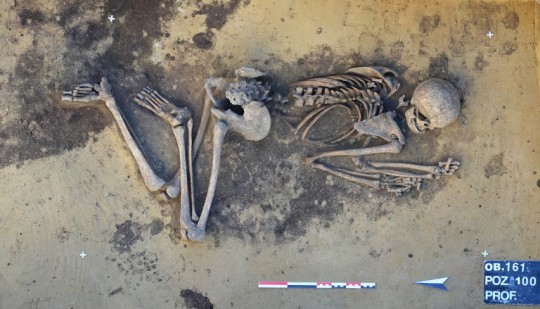

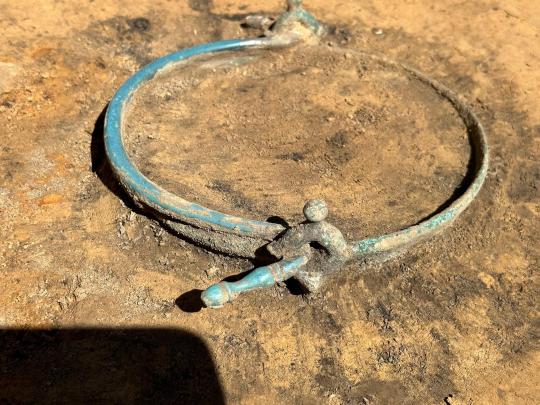

#Rare Roman vessel Found at 2000-Year-Old Burial Site in Poland#Kazimierza Wielka#ancient grave#ancient tomb#ancient urn#ancient artifacts#archeology#archeolgst#history#history news#ancient history#ancient culture#ancient civilizations#Przeworsk culture#roman history#roman empire#roman art#ancient art#art history
101 notes
·
View notes